SGSP E-W Traverse 3 (Green and White Trails)
Sleeping Giant State Park, Hamden, ~5 miles total (solo)
May 1, 2011
As I do not have any idea what – if anything – you’ve previously read regarding my various hikes through Sleeping Giant State Park (on my way to becoming a, -pause-, Giant Master!), allow me to catch you up a bit. On my previous hike back in February (which you can find right here), I crunched through some fairly thick ice on top of a few feet of snow along the White Trail.
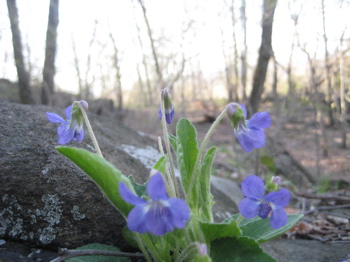
As cool as some of those pictures from that hike look, the day did not go very well. At all. I was recovering from a very painful deep bone bruise/hairline fracture on my heel and 15 minutes into my day I was ahurtin’. So my plan to hike the rocky and often very steep White Trail that day was aborted and I opted for broken out easier trails instead.
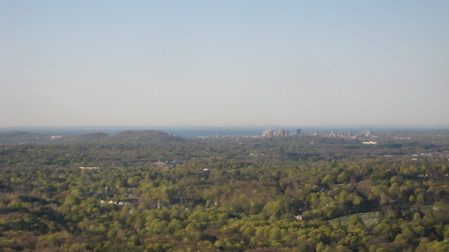
The springtime view of New Haven from the Giant’s chest
Flash-forward three months to a (what I was hoping was a) healed heel, distinct lack of snow drifts and another early morning traipse through the park.
To their immense credit, the Sleeping Giant Park Association requires, -pause-, Giant Masters to walk every foot of every officially blazed foot-hiking trail in the park. They provide prospective, -pause-, MASTERS a sort of spreadsheet with each section of each trail broken down into mini-chunks. The wonderful OCD-beauty of this is twofold: You can select your own routes to completion and you can be very sure you have complied with the rules of the, -wait for it-, GIANT MASTER! program. In other words, previously aborted hikes can be completed easily without skipping a beat. I love this.
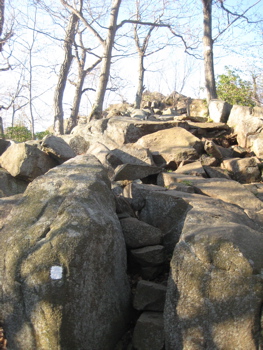
I’m totally going to frame my certificate upon earning the thing.
Anyway, on this spring day I first hiked west, completing the full length of the Green Trail which reaches its terminus at an intersection with the White Trail on some cliffs overlooking the park’s main entrance. From there, I hiked down to the end of the white trail in the picnic grove, turned tail and walked the whole thing back to where I left off in February whereupon I jogged down the already completed Orange Trail (because it is flat) back to my car.
(And now I guess you have figured that my heel held out, without too much pain.)
Green Trail (2 miles)
I had read a few Sleeping Giant trail reviews and blogs that revel in the idea that each trail here explores a unique facet of the park and that with each changing season, new vistas and experiences open up. I sort of scoffed at this notion; I’d read it before about many different hikes and thought to myself that this place was just too small for that effect to take place.
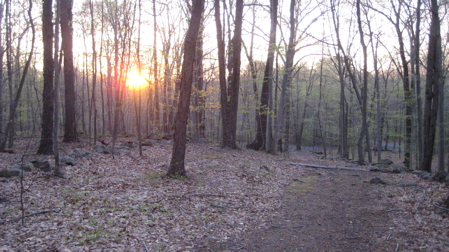
But listen up: It’s true. I don’t know how, but it’s true. Trails that are sometimes less than a quarter mile apart through the woods take on a wholly different feeling from each other. Minor shifts in altitude play a large part, but the trail designers knew what they were doing when they laid out the system throughout the park. It also helps my cause that I’ve purposely chosen to do my five park hikes in five “seasons.” (The four plus winter with no snow.)
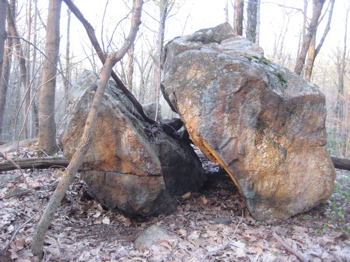
I’d noticed this phenomenon to a lesser degree on previous hikes, but the Green Trail in the spring really made this whole idea crystal clear to me. The little Green Trail – relatively flat and superficially uneventful – ambles through some wetlands and allows the hiker to look up at the Giant’s cliff faces from angles many park visitors never experience.
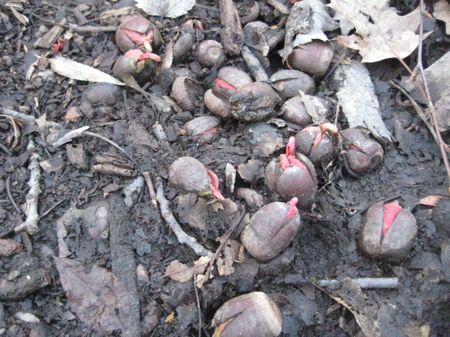
Sprouting acorns
I really dug that. I wonder if anyone has done a survey on what most visitors do here. Nixing the picnickers who don’t count, what percentage of hikers do you think only ever hike the Tower Trail? I would guess maybe 80% or so, but that’s just a guess. Part of me enjoys this because this allows hikers like me to gain solitude in a crowded and small park. But part of me is bummed out by this because, as this website shows, there is beauty, mystery, and interesting things “off the beaten path,” to use an apt cliché.
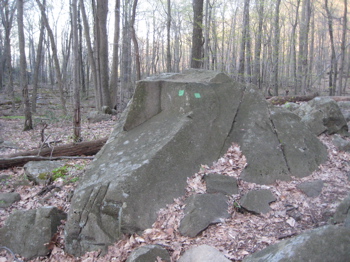
I started the Green in the now-familiar hiker’s lot on Chestnut Lane. Of course I was alone as I was beginning my hike at sunrise. The first half-mile of the Green trail is somewhat familiar after hiking the purple (just a stone’s throw to the north) and the white section (just a stone’s throw 100 feet to the south.) The trail is flat and wide here, as it curves around the base of the Giant’s right foot.
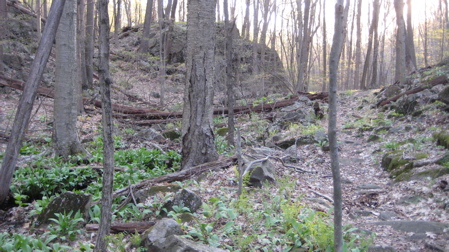
After a short while, the trail sort of follows the cleave between the Giant’s right and left sides. It’s pretty amazing how flat this area is, bounded on both sides by vertical cliffs – on top of which the blue and white trails parallel. I passed by some low-lying wetland areas, just beginning to perk up with skunk cabbage and ferns after being buried in snow for most of the past four months. As I navigated the swampy areas of the trail, the sun had begun to bathe the upper cliffs of the Giant’s left leg across the small ponds. This is what I meant earlier about these little areas of the park that few people appreciate. Especially at this time of day; it was really quite beautiful.
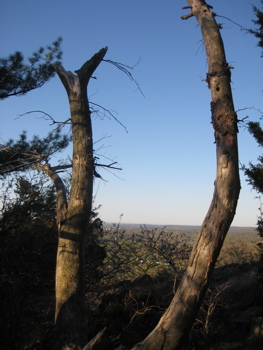
It was me, clear blue sky views to the Sound, and my new best friend – an Eastern Towhee who happily chirped along with me all around the knob. Here he is:
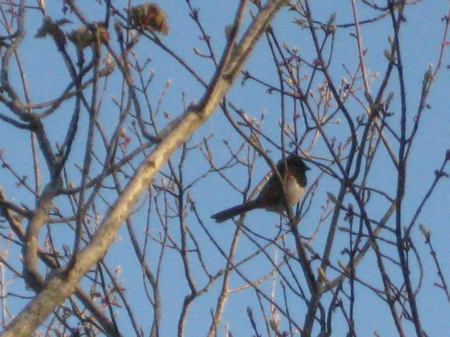
Eastern towhee
Here’s his happy song, if you’re not familiar.
Soon I was directly beneath the famous Sleeping Giant tower (CTMQ Tower report here) and crossing through the area that I trudged across in three-plus feet of snow a few months prior while bushwhacking down from the tower to the orange trail.
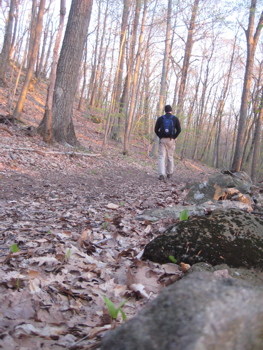
I know it sounds dumb, and this area of the park is nothing more than a hill to the north and open woods all around, but it’s funny to think that last time I was here the snow reached my hips. And now, looking around, everything was greening up and relatively dry and – I’m rambling. I don’t know, I just don’t think I could live anywhere without distinct seasons.
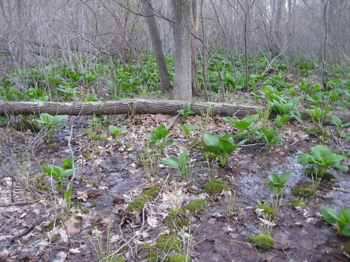
The western end of the green trail does involve a little bit of climbing, up to the giant’s chest. There are some cool tumbled-down rocks through this section, but the true reward is the view at the trail’s terminus atop the “chest.” The viewshed takes in everything to the west and southwest and the open rocks offer plenty of room to lie about for a spell.

And if you’re a completist like me and you’re actually goofy enough to continue on to the end of the white trail (which also crosses the chest) only to turn around and come straight back up here, this view offers a great view of where you’re about to go:

Down there
The green trail is surely one of the Giant’s forgotten trails. Oh, it’s probably not the least hiked (I’ll give that honor to the reds), but I don’t think anyone hikes its length on purpose too often. After all, don’t most people want to hike up on the ridgelines rather than down in the valleys?

I really dig this picture for some reason
Perhaps the green trail is one of those rare times you should rethink your usual plans. I liked it. And so will you.
I’ll present the much more demanding white trail only from west to east (instead of the more confusing reality of my hike), which includes the last mile which I did back in February. Got all that? Good.
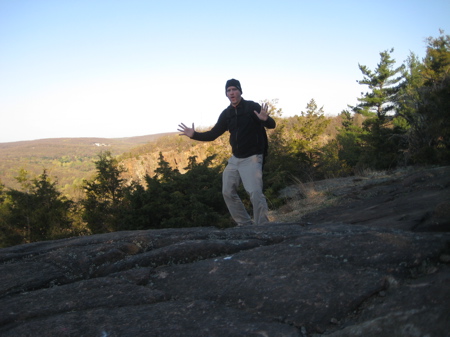
Green Trail: Done
White Trail (2.8 miles)
The white trail and the blue trail are the only ones rated “Hard, steep climbs, for experienced hikers” in the park. The blue trail is, of course, part of the 20 mile Quinnipiac Trail which begins and ends north and east of Sleeping Giant State Park. The white trail is the blue’s cousin to the south, sticking to the jagged ridgeline of the giant’s right side.

As mentioned above, I knew what loomed ahead of me along the first third of the trail because I just came down it. Starting in the picnic grove area of the park, the white trail sort of climbs up along some other trails that make more of an effort to offer switchbacks. It’s funny hiking this bit of the white, because you’ll be the only person doing it while looking over at the people lolligaggling along the orange, nature and tower trails.
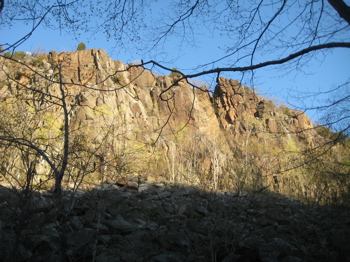
When the white crossed the Tower Trail, several people looked at me like, “Hey buddy, you want to take this trail. It’s much easier and I think you’re lost.” Especially since the white crosses the infinitely more popular tower trail right near where the views of the giant’s chin are at their best (and they’re good… very good) and takes the white blaze hiker straight up into the woods away from the view. Seriously, people just don’t understand why you’d go that way.
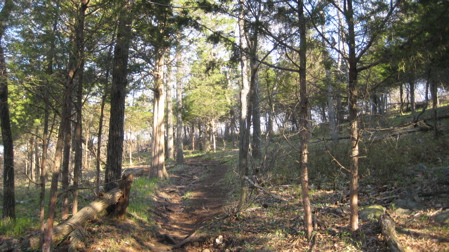
But that’s because they aren’t Masters – Giant Masters. And I’m on way to becoming one. They are masters of nothing. Don’t stare at me.
But the best part of this is that after 10 seconds of bounding up the steep rocks off the Tower Trail, you are alone. Just. Like. That. No more mamas pushing strollers up the graded path, no more overdressed schlubs on their cell phones… just you and the steep up—up-up trail for the next quarter mile or so.
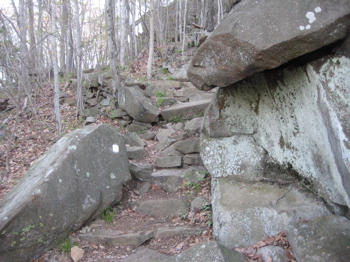
Okay, it’s really not that bad; this is Connecticut after all. But it is a fun scramble and there are definitely some cool rock formations, cliffs and I’ve read there are “caves” around. I didn’t go off in search of any of the caves, as they’re really just chambers under fallen rocks, but I did spend some time checking out the chasm thing up near the top of the giant’s chest – yes, back where the green trail ended.
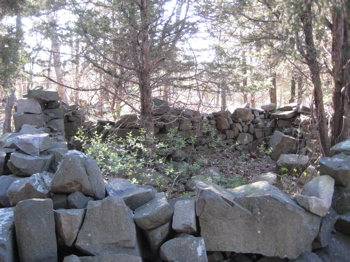
Back up on the chest overlook, right back where I was 40 minutes ago, I felt good as I was about to walk some new-to-me trail. The next little bit was flat along the ridge through some chestnut oak, pine, blueberry and laurel – some of my favorite hiking for some reason. There are tiny patches of this stuff here in Sleeping Giant, and I savor each one.
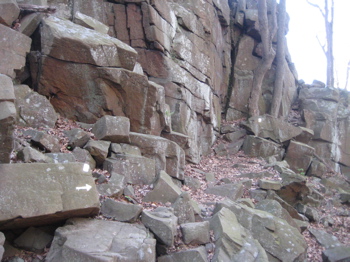
The trail then dips precipitously into a small valley to cross the red circle trail. It’s pretty much straight down and then straight up the other side, which got my heart beating again after the leisurely ridgeline stroll. It was at this point that I remembered back to my icy/snowy/busted heel February attempt at this trail and realized I’d have been doomed if I continued along it as planned. Ugh, I can feel the pain now, sitting in my office chair in August.
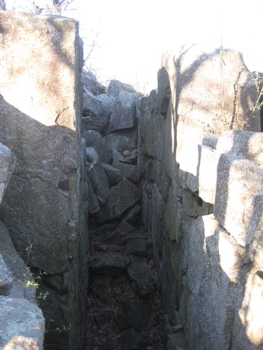
I’ve said it before and I’ll say it again – try to never bust the bottom of your heel.
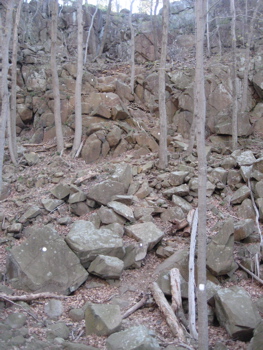
The trail maintainers have done an impressive job with these cliff traverses, I must say. There isn’t too much erosion and the route choice is probably the best possible one. Once back on top of the ridgeline, (now on the right knee) I found a curious piece of litter: an almost full pack of cigarettes. You’d be amazed at how of many these things I’ve found over the years and the funny part is that they always seem to be at the top of hard climbs.
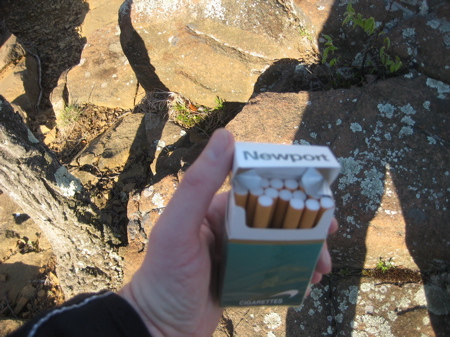
I just envision the smoker struggling to attain the top and upon doing so, short of breath and lungs searing, yelling out to the gods that they are never smoking again and to prove it, they start the new bad habit of littering. (Yes, I packed them out.)
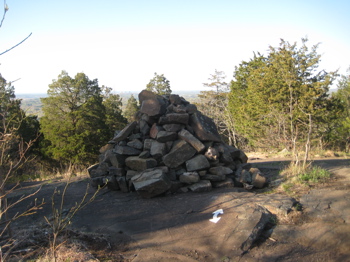
Right after the right knee, the white trail intersects with the orange – which I took back out to my car. This is where I quit the white back in February so now the pictures will change from springtime renewal to 3 feet of ice covered snow. It’s sort of like The Wizard of Oz in reverse. Not really, but I’m not changing that sentence.
This last bit of the white trail traverses Hezekiah’s Knob which is yet another little treeless viewspot. And yes, it’s sort of shaped like a knob. The idyllic wintertime views I had were beautiful to say the least. I was pretty much the only person in the park at dawn on a day when hiking was borderline impossible.
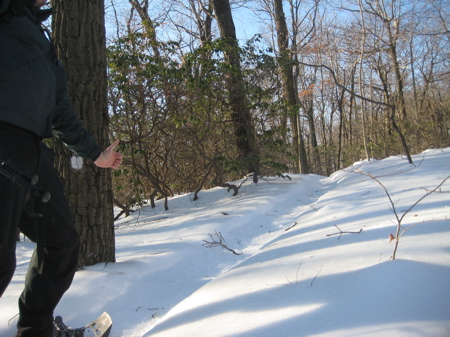
You can sort of see how deep the snow is by the blaze height
I loved it. After the Knob, the trail rises again about over the giant’s right foot and then ambles down to the hiker lot on Chestnut Lane. I took a load of pictures here because I was trying to get a picture that accurately showed not only the depth of the snow, but also the high degree of difficulty the ice layer was providing. I never quite succeeded in doing that, but I think you get the point.
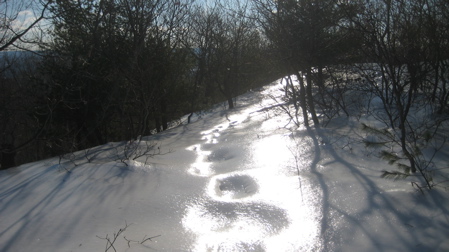
The green and the white trail are very different trails, both more or less starting and ending in the same place and only situated maybe a quarter mile apart on average. One is fairly difficult and the other is super easy. One sticks to the rocky ridges and cliffs while the other mosies along next to wetlands and under the cliffs.
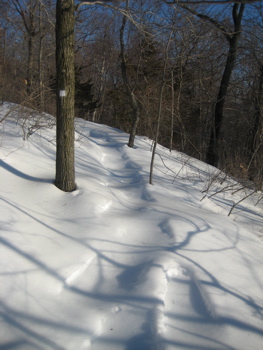
And when you think about it, doing this loop makes for a pretty darn interesting morning.
I should also note that I did the blue/white connector and the easternmost yellow/green connectors during my hike. That’s important… to fellow GIANT MASTERS.
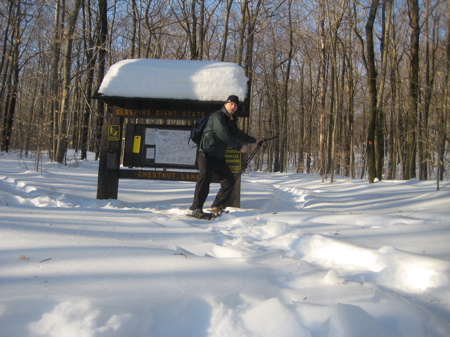
White Trail: Done
CTMQ’s Sleeping Giant Hikes
Sleeping Giant Park Association
Sleeping Giant State Park map

Leave a Reply